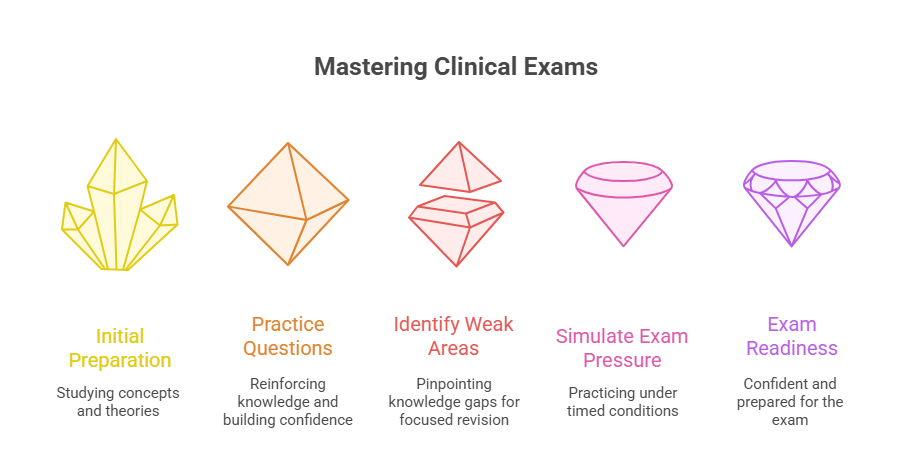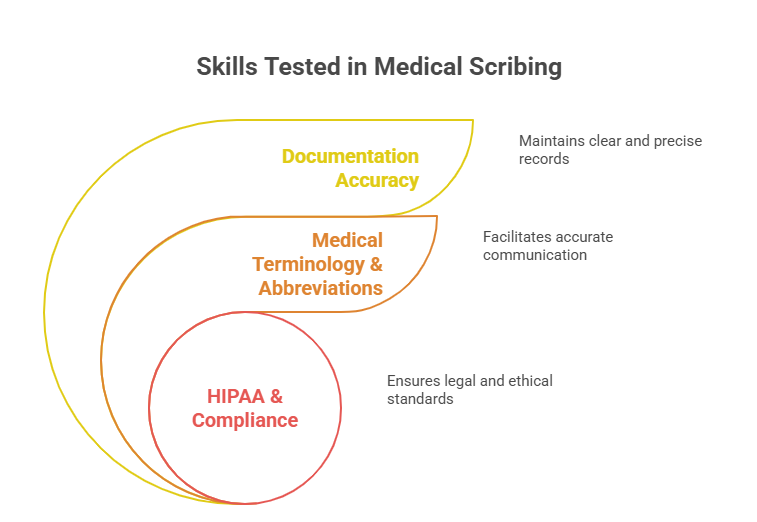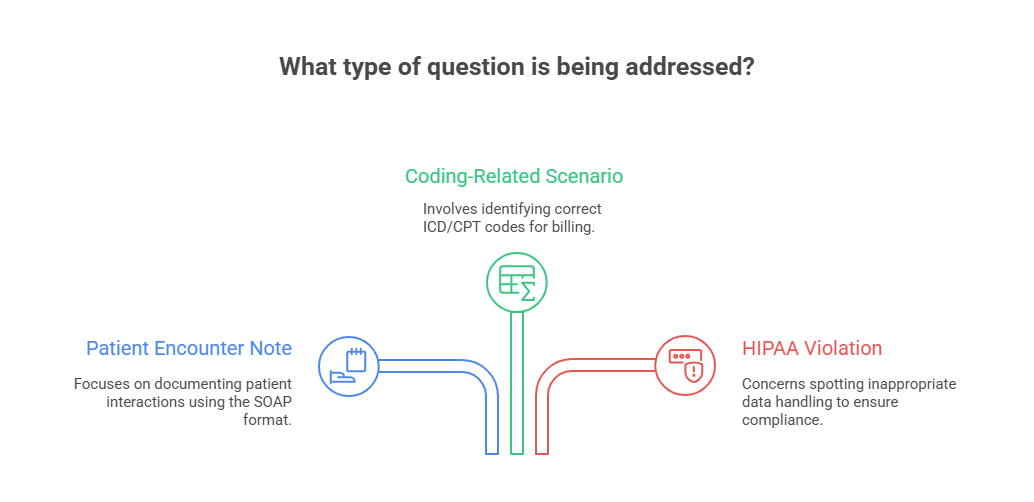Medical Scribe Certification: Real-Life Exam Questions & Expert Answers
The medical scribe certification exam is not designed to test rote memorization—it evaluates whether you can apply documentation skills, compliance knowledge, and medical terminology under pressure. Real-life exam questions mirror the fast-paced environments of clinics and hospitals, where accuracy is critical and mistakes carry consequences. Passing requires more than studying definitions; it requires practicing with questions that reflect the exam’s exact style and complexity.
This guide delivers exactly what students need: real exam-style questions with expert answers, strategies for tackling scenario-based items, and insights into common categories that dominate the test. By working through these examples and approaches, you’ll sharpen your accuracy, strengthen recall, and walk into the Medical Scribe Certification by ACMSO prepared for real exam conditions—not just theory.
Why Practice Questions Matter
Reinforcing Key Concepts
One of the fastest ways to strengthen retention for the medical scribe certification exam is through targeted practice questions. Reading alone creates passive recognition, but exam questions force active recall, which is proven to increase memory retention significantly. For example, being asked to transcribe part of a SOAP note or correct a charting error makes you actively retrieve rules and terminology instead of just recognizing them. Each correctly answered question builds fluency, while each mistake identifies gaps. By continuously reinforcing concepts through applied questioning, candidates transform abstract knowledge into exam-ready skills that mirror the realities of patient documentation.
Familiarity with Question Types
Another key advantage of practice questions is building familiarity with how exam items are structured. The Medical Scribe Certification by ACMSO includes multiple-choice questions, charting simulations, and compliance scenarios. Without practice, students are caught off guard by subtle wording, distractor answers, or time-intensive case studies. Exposure to these styles ahead of time reduces cognitive load on test day. Instead of struggling to interpret question format, you’ll focus energy on applying knowledge. Familiarity also builds speed—you learn to quickly identify the right approach for each type of question, from terminology matching to complex HIPAA violation analysis, ensuring efficient performance across all sections.
Common Question Categories in the Exam
Documentation Accuracy Questions
One of the heaviest-weighted categories on the medical scribe certification exam is documentation accuracy. These questions simulate real patient encounters and require you to spot missing details, transcription errors, or improper structuring of SOAP notes. For example, you may be asked to correct a misaligned patient history or identify where a provider’s dictation was improperly recorded in an EMR. Documentation accuracy matters because even a small mistake can compromise compliance, delay treatment, or mislead clinicians. Practicing these questions conditions you to proofread critically and document with the precision employers expect. Accuracy in this category often decides whether candidates pass or fail.
Medical Terminology and Abbreviations
A second core category involves medical terminology and abbreviations. These questions test whether you can distinguish between similar terms, interpret abbreviations correctly, and apply terminology in context. For instance, confusing “ileum” with “ilium” could lead to errors in patient charts. Questions often ask you to expand abbreviations, match terminology to body systems, or select the correct term in a case scenario. This section is designed to assess fluency, not just memorization—can you use terms correctly in documentation tasks under time pressure? Mastery here ensures you can document encounters without introducing ambiguity or risk.
HIPAA and Compliance Scenarios
The Medical Scribe Certification by ACMSO also tests compliance rigorously. Expect scenario-based questions where you must identify HIPAA violations or choose the correct ethical response. Examples include handling overheard patient information, determining when disclosure is permitted, or recognizing improper EMR access. While some students dismiss these as “easy,” they carry high weight because compliance errors have real-world legal and financial consequences. Strong preparation here ensures not only exam points but also professional safety when working in healthcare environments.
Sample Real-Life Questions with Expert Answers
Example 1: Patient Encounter Note
Question: A physician dictates: “The patient reports chest pain lasting two hours, worsened by exertion, relieved by rest.” The student transcribes: “Patient has chronic chest pain for two hours, unchanged by rest.” What’s the error?
Expert Answer: The transcription misrepresents both chronicity and modifiers. The patient’s complaint was acute (lasting two hours), not chronic. Additionally, the dictation noted pain was relieved by rest, not unchanged. Errors like these distort clinical interpretation and affect care. On the exam, always cross-check tense, time qualifiers, and modifiers against dictation to ensure documentation accuracy, a core scoring category.
Example 2: Coding-Related Scenario
Question: A provider documents “Type II diabetes mellitus with neuropathy.” Which ICD-10 coding description should the scribe select?
Expert Answer: The correct code aligns with E11.40 – Type II diabetes mellitus with diabetic neuropathy, unspecified (if details aren’t provided). Candidates often choose a more general diabetes code, missing the associated condition. The exam tests whether you recognize linked comorbidities. The safe strategy: always document and code both the primary disease and any linked complications when specified. In practice, failing to capture neuropathy would underreport patient risk.
Example 3: HIPAA Compliance Violation
Question: During a break, a scribe discusses a patient’s diagnosis with a friend in the cafeteria. What HIPAA rule has been violated?
Expert Answer: This is an unauthorized disclosure of protected health information (PHI) in a public setting. HIPAA requires that PHI remain private except for treatment, payment, or healthcare operations. The violation is not about intent—it’s about exposure risk. On the exam, the correct answer is to never disclose patient details outside the care team, regardless of location or casual context.
Strategies for Answering Scenario-Based Questions
Using Context Clues
Scenario-based questions on the medical scribe certification exam often present details that seem overwhelming. The key is to anchor yourself in context clues. For example, if a patient encounter note includes timing words like “acute” or “chronic,” these define the correct documentation. Similarly, compliance questions may hinge on whether the disclosure involves treatment, payment, or unauthorized sharing. Train yourself to highlight modifiers, timeframes, and setting-specific details. These clues eliminate wrong answers quickly and direct you to the one that aligns with both clinical accuracy and compliance. Ignoring context is one of the fastest ways to lose points on applied questions.
Eliminating Distractors
Exams include distractors—answers that look plausible but are slightly inaccurate. On the Medical Scribe Certification by ACMSO, distractors often use correct medical terms applied in the wrong context, or answers that are technically true but irrelevant to the scenario. To handle them, first rule out obviously wrong options, then test the remaining answers against the specific scenario presented. Ask yourself: “Does this answer reflect the exact patient situation or compliance detail given?” If it doesn’t, eliminate it. This structured narrowing process prevents second-guessing and helps ensure speed without sacrificing accuracy.
| Strategy | Description | Why It Works |
|---|---|---|
| Using Context Clues | Break down scenario language to find embedded hints | Improves interpretation and reduces wrong choices |
| Eliminating Distractors | Remove clearly incorrect or unrelated options first | Narrows down high-probability answers |
| Think Clinically | Apply logic used in real patient encounters | Makes your responses grounded in real-world practice |
Improving Accuracy and Speed with Practice
Time-Bound Mock Exams
One of the most effective ways to sharpen performance is through time-bound mock exams. Many candidates know the content but lose points because they mismanage pacing. Simulating the actual exam conditions—timed sections, no interruptions, and exam-like formatting—builds both accuracy and speed. For example, set a timer to complete 50 documentation and compliance questions within an hour. Review not only your score but also how long you spent per question. Over time, you’ll learn to recognize when to move on and when to commit. This practice builds the mental stamina needed for the real exam, where every minute counts.
Tracking Mistakes for Targeted Review
Equally important is systematically tracking your mistakes. Every incorrect answer on a practice test highlights a specific weakness—whether in terminology, EMR navigation, or HIPAA compliance. Simply retaking questions without analysis leads to repeated errors. Instead, maintain an error log: document the question, the wrong answer chosen, and why it was incorrect. Then review similar concepts until mastery is achieved. This approach ensures study time is laser-focused on weak points, improving efficiency. By treating mistakes as data, you convert failures into targeted learning. Over weeks, this method produces significant gains in both accuracy and recall speed.
| Practice Method | Tool Used | Impact on Performance |
|---|---|---|
| Time-Bound Mock Exams | Digital timed simulations | Boosts speed and simulates test-day pressure |
| Error Tracking Logs | Excel sheets or apps like Anki | Focuses revision on recurring mistakes |
| Weekly Question Reviews | Printed practice sets | Improves long-term memory and reduces careless errors |
How the Medical Scribe Certification by ACMSO Prepares You for Real Exam Questions
The Medical Scribe Certification by ACMSO is structured to do more than test memory—it prepares candidates to perform with precision in real-world medical environments. Where other certifications may lean heavily on recall, ACMSO emphasizes applied skills, scenario accuracy, and compliance awareness, which directly align with the most challenging exam questions.
First, ACMSO provides a transparent exam blueprint. Candidates see exactly how questions are distributed across domains like documentation, medical terminology, and HIPAA compliance. This prevents wasted study time on low-yield topics and ensures preparation matches the exam’s true weight distribution. You know where to focus, and you train smarter.
Second, the certification includes scenario-based practice materials. These mirror the exam’s real-life style, such as patient encounter notes, EMR charting tasks, and compliance dilemmas. Working through these simulations builds fluency in applied knowledge, helping you spot and avoid distractors on test day. Candidates who train with ACMSO resources walk into the exam already conditioned for its exact question style.
Third, ACMSO emphasizes documentation accuracy and compliance drills, two areas that often decide pass or fail. Through practice, you learn how to identify transcription errors, structure SOAP notes, and handle HIPAA-sensitive scenarios correctly. These drills sharpen attention to detail, a skill that protects points on the exam and builds credibility in the workplace.
Fourth, ACMSO prepares you for the time management element of the exam. Mock exams, pacing strategies, and timed drills ensure you develop the stamina to complete all sections efficiently. Instead of panicking in the final minutes, you’ll rely on rehearsed strategies for prioritizing straightforward questions and circling back to complex ones.
Finally, this certification equips you for the career impact beyond the exam. Employers recognize the ACMSO credential as proof you’re not just certified, but job-ready. By preparing you with applied, exam-style practice, ACMSO ensures your test success translates into immediate workplace performance. For students, this means higher employability, stronger earning potential, and long-term growth opportunities.
The Medical Scribe Certification by ACMSO doesn’t separate exam readiness from professional readiness—they are one and the same. That’s why its candidates consistently perform better on real exam questions and transition seamlessly into clinical roles.
Frequently Asked Questions
-
The medical scribe certification exam is a professional credentialing test designed to evaluate a candidate’s readiness to document patient encounters, navigate EMR systems, and apply HIPAA compliance rules. Passing it signals to employers that you can perform in high-pressure healthcare environments without extensive training. Certification opens the door to higher-paying roles, career advancement, and credibility in competitive hiring pools. In an industry where documentation errors directly affect patient safety and physician efficiency, holding this certification demonstrates you can deliver precision and reliability. Employers increasingly prefer certified scribes, making the exam an essential step for long-term success.
-
The Medical Scribe Certification by ACMSO blends multiple-choice and scenario-based questions. Candidates face documentation accuracy challenges, terminology and abbreviation drills, HIPAA compliance scenarios, and workflow efficiency tests. For example, you may be asked to transcribe part of a SOAP note, expand abbreviations correctly, or spot a compliance violation in a simulated patient encounter. The exam is designed to reflect real-world situations, not just textbook definitions. Scenario-based items typically carry more weight, as they test your ability to apply knowledge in clinical contexts. Familiarity with these question types is critical for scoring well and demonstrating applied competence.
-
Preparation requires more than memorization. For the ACMSO exam, prioritize three strategies: active recall, simulation practice, and timed mock exams. Use flashcards for medical terminology, transcription drills for documentation accuracy, and compliance case studies for HIPAA mastery. Dedicate 1–2 hours daily for 6–8 weeks, with weekly full-length practice tests under timed conditions. After each test, track mistakes and review weak areas systematically. This approach ensures balance: you’re building speed, strengthening recall, and conditioning yourself for exam pressure. Relying on just reading notes or textbooks will leave you unprepared for the applied nature of the test.
-
The medical scribe certification exam is moderately challenging. Most candidates agree it requires steady preparation rather than advanced clinical expertise. The difficulty comes from the applied nature of questions—transcription accuracy, HIPAA compliance, and EMR workflows are tested under time constraints. Students who underestimate this and focus only on memorization tend to struggle. With consistent study across 6–8 weeks, the exam is very achievable. Success depends on how well you integrate both content knowledge and practical application. Candidates who practice real-life scenarios and use time-bound mock exams generally find the difficulty manageable and pass confidently on the first attempt.
-
The most common mistakes include ignoring the exam blueprint, over-relying on a single resource, skipping full-length mocks, and underestimating compliance questions. Many students focus too much on terminology memorization while neglecting documentation drills, which often carry more weight. Others attempt to cram in the final week, which increases anxiety and reduces retention. Another frequent error is not practicing under timed conditions, leading to pacing problems during the actual exam. To avoid these pitfalls, use diverse resources, follow the official blueprint, and practice consistently. Effective preparation means balancing recall, accuracy, and speed—not just studying harder at the last minute.
-
The Medical Scribe Certification by ACMSO stands out because of its applied focus. Unlike credentials that lean heavily on definitions or terminology recall, ACMSO integrates patient-encounter scenarios, EMR charting tasks, and compliance case studies. This ensures certified scribes are not only exam-ready but job-ready. Employers value ACMSO because it reduces onboarding time and guarantees documentation competence from day one. Compared to general certifications, ACMSO’s transparent blueprint and scenario-based resources give candidates an advantage in both preparation and professional credibility. For students serious about long-term healthcare careers, ACMSO certification offers stronger recognition and faster career acceleration.
Conclusion
Preparing for the Medical Scribe Certification exam can feel overwhelming, but the key is practice with real-life exam questions and learning from expert answers that show you not just the “what,” but the “why.” By focusing on clinical documentation accuracy, medical terminology, HIPAA compliance, and speed in EHR navigation, you’ll be positioned to perform confidently on exam day.
This certification is more than a credential — it’s proof that you can handle real-world clinical demands with precision. Whether you’re entering healthcare for the first time or advancing your career, mastering these practice questions gives you the edge to succeed.
Take the time to review, practice, and refine your skills. The Medical Scribe Certification is your gateway to standing out in a competitive job market and becoming an indispensable part of any healthcare team.





